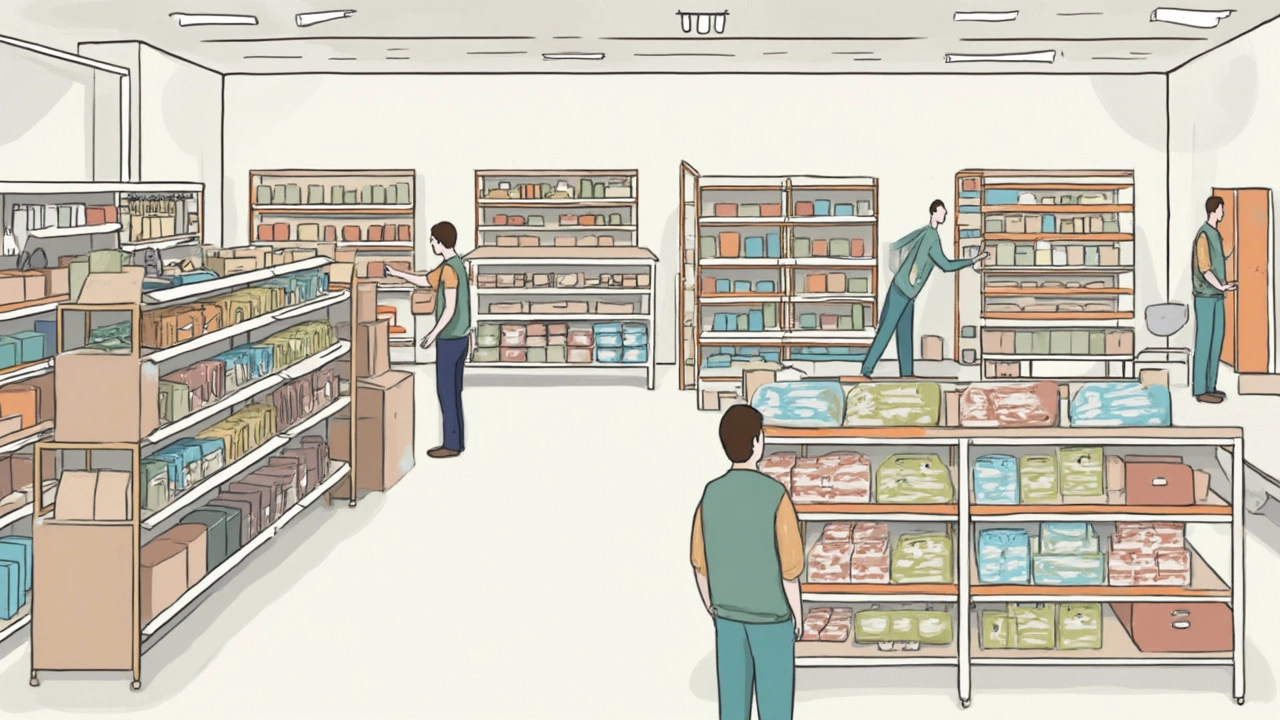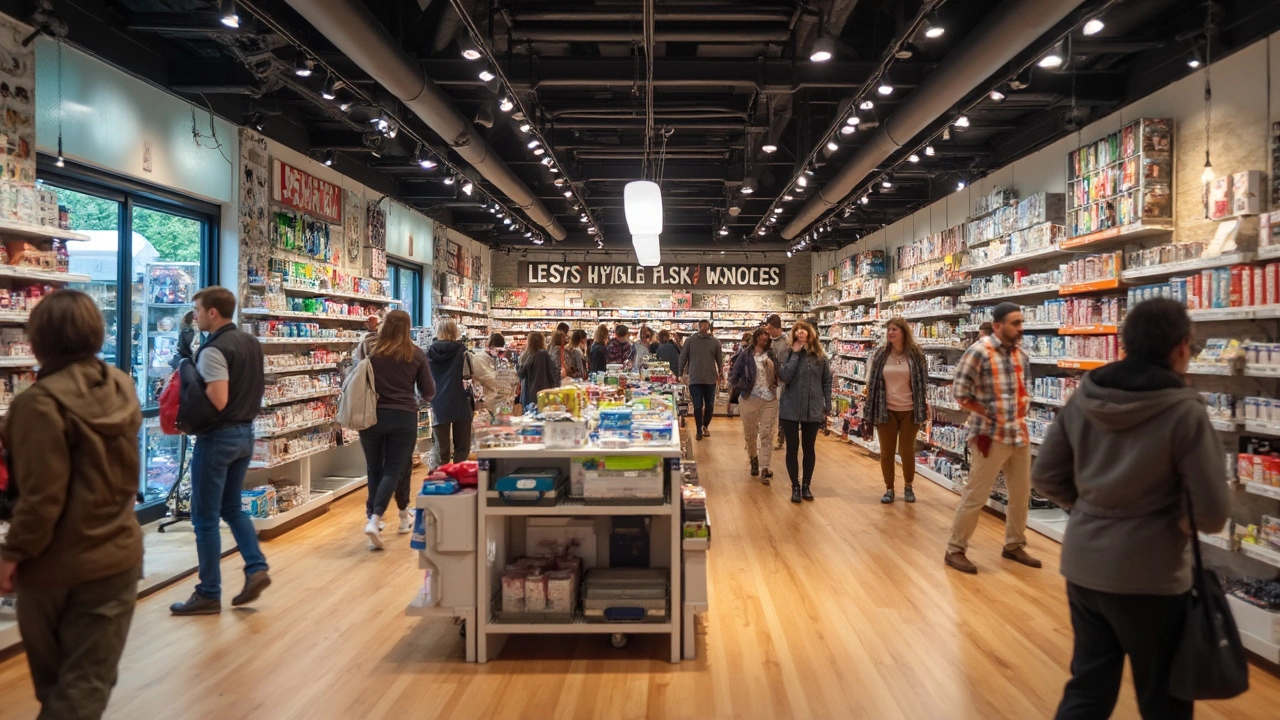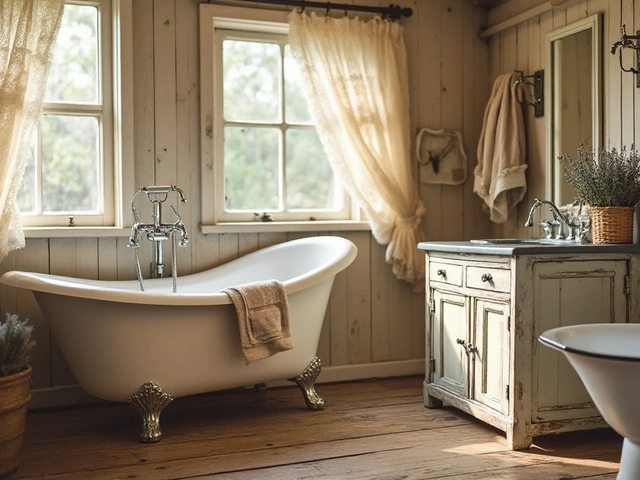Walk into any store and you see a sea of shelves packed with stuff, but have you ever stopped to think about what these shelves are actually called? Sure, "shelf" is the everyday word, but if you ask anyone in retail, they'll get specific—terms like gondola shelving, display racks, and wall shelving get tossed around all the time.
Why does the name matter? If you're setting up a shop, or even if you're shopping for home use, knowing the right terms helps you find exactly what you need. Ever asked a hardware guy for "those metal shelves you see at the grocery store"? Odds are, you'll get a faster answer if you know to say "gondola shelving." Even on secondhand sites or at auction warehouses, using these names will get you better search results.
Different types of store shelving aren’t just about looks. Stores pick certain shelves because they change what you notice, where you reach, and even how much you buy. Some designs make you slow down, others guide you to promotions, and some help prevent theft—a whole lot more to shelving than meets the eye.
- What Store Shelving Is Really Called
- Main Types of Store Shelving
- How Stores Use Different Shelves
- Materials and Features to Know
- Shelving Mistakes to Avoid
- Tips for Picking the Right Shelving
What Store Shelving Is Really Called
Most people just call it shelving, but in retail, you’ll hear all kinds of names. The terms matter, especially when you're talking to suppliers or planning a store layout. The big ones you’ll bump into all the time are gondola shelving, display racks, wall shelving, end caps, and pegboard shelving.
Store shelving is the general term, but once you get specific, things get a lot clearer. Here's a quick breakdown:
- Gondola Shelving: These are the sturdy, double-sided shelves you see in the middle of supermarkets. They're the workhorses—versatile, easy to rearrange, and able to carry heavy loads. Every grocery or discount store has them.
- Wall Shelving or Wall Units: These are one-sided shelves that sit up against the store walls. They're great for maximizing space along the sides of a shop.
- Display Racks: Think of racks as stand-alone structures showing off particular products: clearance bins, magazine racks, or spice racks.
- Pegboard Shelving: This type comes with holes and pegs—like what you see at hardware stores to hang tools and accessories. It's flexible and makes products easy to reach.
- End Caps: If you’ve ever grabbed a hot new product at the end of an aisle, that’s an end cap. Stores use these to highlight promos and new arrivals. They actually boost impulse sales by a surprising amount.
Names aren’t just for show—they help organize a whole industry. If you peek at supply catalogs or retail trade shows, you'll see these words everywhere. Just so you can see how shops split up their shelf space, here’s a table showing a typical U.S. supermarket’s breakdown by percentage of shelving types:
| Shelving Type | Percent of Floor Space |
|---|---|
| Gondola Shelving | 50% |
| Wall Shelving | 25% |
| End Caps | 10% |
| Display Racks | 10% |
| Pegboard Shelving | 5% |
Next time you’re in a store, glance around and see if you can spot which is which. It’s not just a shelf—it’s all about putting the right product, in the right place, at the right time.
Main Types of Store Shelving
There’s a lot more to store shelving than just a place to park products. Different shelves serve different jobs, and knowing what’s what can make all the difference—whether you’re setting up a shop or just scanning for deals at wholesale outlets.
Here are some of the most common store shelving types you’ll spot in retail:
- Gondola Shelving: These are the workhorses of supermarkets and convenience stores. They have a flat base, vertical supports, and adjustable shelves on both sides, making them easy to shift around. They form most of the “aisles” you see in grocery stores. Fun fact: One study found about 68% of supermarket shelving falls into this category.
- Wall Shelving (or Wall Units): As the name says, these fixed shelves attach straight to the wall, so you only have access from one side. They’re perfect for showing off snacks, beauty products, or anything you want lined up at eye-level as folks walk by.
- Display Racks: If you see baskets of fresh produce, wire racks with bread, or stands for impulse buys near the checkout, that’s display racks at work. They make small or seasonal items stand out fast.
- End Cap Units: These sit at the ends of aisles, right where your eyes—or your cart—tend to land first. Stores use end caps for hot deals or attention-grabbing new products. According to retail data, items placed on end caps can sell up to 30% faster than when placed mid-aisle.
- Island Shelves: These standalone fixtures work best for promotions or new launches. You can walk around them from all sides, which is great in big box stores or open floor plans.
- Counter Shelving: You’ll find these right at the checkout counters. Think gum, candy, or small electronics—anything designed for a quick, last-minute buy.
Want to compare at a glance? This basic table covers some differences:
| Type | Main Use | Accessibility | Typical Location |
|---|---|---|---|
| Gondola Shelving | Everyday merchandise | Both sides | Aisles |
| Wall Shelving | Lighter/high-rotation items | One side | Perimeter walls |
| Display Racks | Specialty/promo | One side or open | Flexible spots |
| End Cap Units | Promotions/best-sellers | One/two sides | Aisle ends |
| Island Shelves | Promos/seasonal | All sides | Open floor |
| Counter Shelving | Impulse buys | One side | Checkout area |
Each type has its perks, and stores pick based on space, shopper flow, and how fast they want products to move. The next time you’re in a store, see if you can spot all six—knowing what’s what actually helps if you’re planning layouts or just curious about how merchandising works.
How Stores Use Different Shelves
Most stores are way more strategic with their shelving than you might think. The type and placement of shelves can totally change how customers move, what catches their eye, and what they end up buying. In other words, the layout isn’t just about fitting products on the floor—it's all about store shelving working behind the scenes to boost sales.
Grocery stores use gondola shelving for a reason. These double-sided rows are strong, easy to move, and hold a ton of products. You’ll see the same setup in drugstores and convenience shops. End caps—the shelves at the end of each aisle—are like premium advertising real estate. Brands will even pay extra to get their stuff on these spots because shoppers are three times more likely to grab something from an end cap than from a random shelf.
Wall shelving, sometimes called wall bays, helps make the most of every square foot. Liquor stores load these up behind the counter, while clothing stores neatly display jeans and shirts with wall systems to keep everything visible (and stop stuff from getting buried).
Display tables and dump bins sound funny but do exactly what the name says—they let stores pile up products so you’re tempted to pick one up. You see these for quick-grab items like candy or discounted gadgets. Retail research says sales can jump as much as 20% when bins or tables get placed at the front of the store during busy hours.
Check out counters and impulse racks are tiny but mighty. They’re the reason you suddenly want a pack of gum or lip balm while waiting in line. Retailers bank on the fact that around 60% of shoppers make unplanned purchases from these racks.
Here’s a quick look at where you might find each type:
| Type of Shelf | Common Location | Main Purpose |
|---|---|---|
| Gondola Shelving | Aisles (grocery, pharmacy) | Stock large quantity items, easy browsing |
| End Caps | Ends of aisles | Highlight promos, draw attention |
| Wall Shelving | Perimeter, behind counters | Display variety, save space |
| Display Tables | Store entrance, main walkways | Promote new/seasonal goods |
| Impulse Racks | Checkouts | Push last-minute buys |
If you’ve ever wondered why you always leave with more than you planned, it’s not by accident—the right shelf, in the right place, really does the trick.

Materials and Features to Know
Not all store shelving is created equal. Walk down the aisles at a supermarket or drugstore and you'll see a mix of materials—each one picked for good reason. Here’s what matters most when you’re picking shelves for a store or even for your garage.
Most commercial shelving is made from steel, because it’s tough, stays strong even under stacks of canned goods, and doesn’t get beat up easily. Powder-coated steel is pretty standard since it resists rust and looks newer for longer. Want shelves that don’t dent or wobble? Stick with steel.
If you need a warmer look, think about wood or wood laminate. These are more common in boutique shops or specialty stores. Real wood looks great but costs more and can scratch. Laminates are cheaper and don’t mind a spill—but don’t expect them to last forever if you overload them.
Wire shelving is lighter and allows for better airflow, perfect in places like bakeries or storage rooms where moisture can build up. Plastic shelving is rare, but you might spot it in quick setups or places where you see a lot of spills since it’s easy to wipe down and doesn’t rust.
So, what about features? Most store shelving comes with adjustable shelves, which let you fine-tune the height for whatever you’re displaying. End caps—the shelves at the end of each aisle—are prime real estate in retail; they grab attention and move extra product.
- Adjustable heights : Move shelves up or down for tall or short products.
- Pegboards : Great for hanging items like tools, snacks, or accessories.
- Label holders : So shoppers can spot prices or product info fast.
- Lighting : Some modern units pop in built-in LEDs to really highlight products.
- Locking features : Handy in areas with high-value goods or if you leave stuff out overnight.
Here's a quick look at how materials stack up:
| Material | Durability | Main Use | Pros | Cons |
|---|---|---|---|---|
| Steel | High | Grocery, hardware, general retail | Tough, long-lasting, supports heavy loads | Heavier, can be pricey |
| Wood/Laminate | Medium | Boutique, specialty, display cases | Looks good, warms up the space | Can scratch, real wood needs care |
| Wire | Medium | Bakeries, storage rooms, produce | Lightweight, allows airflow | Not for really heavy stuff |
| Plastic | Low-Medium | Quick setups, wet areas | No rust, easy to clean | Not super sturdy, limited styles |
Always check with your supplier or the label to pick the shelving that matches what you’re selling. The right features and the right material make all the difference—and save you headaches down the road. If you want store shelving that stands up to daily use, store shelving with steel frames and adjustable parts usually outlasts the rest.
Shelving Mistakes to Avoid
Getting shelving wrong can turn even the best store setup into a mess. The most common issue? Not matching the shelving type to what you’re selling. You can cram a shelf with cans, but try doing that with pillows or shoes, and it looks terrible plus ruins the shopping experience.
Here are some mistakes people run into, especially with store shelving:
- Overloading shelves: Every shelf has a weight limit. Most basic gondola units hold 200-400 pounds per shelf, but overloading can lead to bent shelves—or worse, collapsed units that are dangerous for customers and staff.
- Ignoring shelf height: Place your best products too high or too low, and shoppers won’t see them. Eye level sells best; there’s real data behind this. A 2023 retail analytics survey showed products at second-shelf height sold 27% better than those on bottom shelves.
- Using the wrong material: Wood shelving looks pretty, but doesn’t work for heavy items and wears down fast in high-traffic areas. Metal is better for supermarkets, while acrylic works for lightweight or designer goods.
- Lack of organization: If items aren’t grouped logically, customers get frustrated. Confusing layouts cost sales. For example, a study by the National Retail Federation found stores with organized displays had 31% higher product visibility rates.
- Blocking light and walkways: Bulky shelving can mess up lighting and flow. If people have to squeeze by, carts get stuck and people get annoyed. Aisles should be at least 36 inches wide, based on universal design recommendations.
Take a look at this quick comparison—see how these mistakes stack up in real stores:
| Mistake | Potential Problem | What It Costs You |
|---|---|---|
| Overloaded shelves | Bending, collapsing | Safety risk, lost products |
| Poor shelf height choice | Missed sales | Lowered product visibility |
| Cheap/wrong materials | Breakage, worn look | Replacement costs, bad impression |
| Bad organization | Customer confusion | Lost sales |
| Narrow aisles | Traffic jams | Annoyed shoppers |
One last piece of advice: always walk your store as if you’re a customer. Notice how easy it is (or isn’t) to grab what you want. That’s the fastest way to spot hidden shelving problems—before shoppers do.
Tips for Picking the Right Shelving
Choosing store shelving isn’t just grabbing whatever fits the space. There are real factors that help decide what works best for your products and your customers. Make the wrong pick and stuff can fall off, pile up unevenly, or even go unsold because people just don’t see it.
- Store shelving should actually support what you’re selling. Heavy items need strong metal gondola shelves—don’t risk bending cheap wire shelving with stuff like canned food or cleaning products.
- Think about visibility. Clear open shelving for snacks or cosmetics works better than high racks that hide products behind other items.
- Modular designs are gold. Shelving that lets you move shelves up or down or add hooks is way more flexible, especially if your products or seasons change a lot.
- Space matters. Most shops struggle with crowding. Slim gondola shelving can create aisles without feeling cramped, and wall units free up floor space.
- Safety first—check for shelving with good anchoring options, especially if you have lots of foot traffic or families with kids. Wobbly or overloaded shelves are an accident waiting to happen.
- Looks count, too. Customers actually spend more time browsing products at stores that don’t look cluttered. A tidy, matching shelving setup can boost sales just by making things easier to find.
Want to compare at a glance? Here’s a handy table that shows which shelving types work best for different store settings:
| Shelving Type | Best For | Notes |
|---|---|---|
| Gondola Shelving | Grocery, pharmacy, general retail | Sturdy, free-standing, adjustable |
| Wall Shelving | Apparel, electronics, specialty | Space-saving, great for display |
| Display Racks | Seasonal items, new arrivals | Portable, eye-catching |
| Wire Shelving | Stock rooms, lighter products | Affordable, easy to clean |
Don’t forget about height. Shelf heights between 36 and 48 inches are proven to reach more shoppers easily, because most adults can browse products at this range without stretching or crouching. Finally, always double-check if a supplier’s measurements are with or without end caps—those little inches can mess up your whole plan if you’re not careful.







